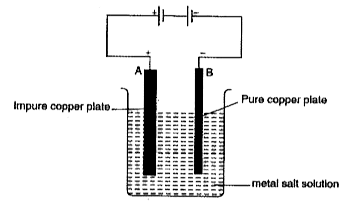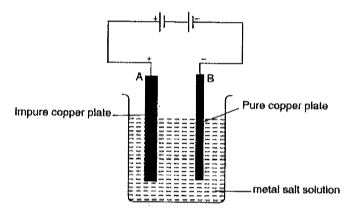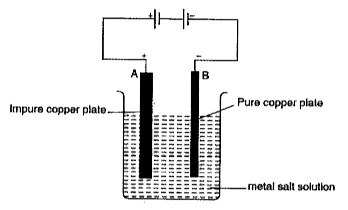The process that you saw in Activity 14.7 is used for purification of copper. A thin plate of pure copper and a thick rod of impure copper are used as electrodes. Copper from impure rod is sought to be transferred to the thin copper plate. Which electrode should be attached to the positive terminal of the battery and why?
To determine which electrode should be attached to the positive terminal of the battery in the process of purifying copper, follow these steps:
1. Identify the Electrodes: We have two electrodes: a thin plate of pure copper and a thick rod of impure copper.
2. Understand the Process: The goal is to transfer copper from the impure copper rod to the pure copper plate. This process is known as electrolysis.
3. Charge of Copper Ions: Copper ions (Cu²⁺) are positively charged. In an electrolysis setup, positive ions move towards the negative electrode (cathode) and negative ions move towards the positive electrode (anode).
4. Determine the Role of Each Electrode:
- The thin plate of pure copper will act as the cathode (negative electrode) because it is where the copper ions will be deposited.
- The thick rod of impure copper will act as the anode (positive electrode) because it is where the copper ions will be released into the solution.
5. Connect the Electrodes: Since the copper ions are positively charged and will move towards the cathode, the thick rod of impure copper (anode) should be connected to the positive terminal of the battery.
Conclusion:
The thick rod of impure copper should be attached to the positive terminal of the battery because it serves as the anode, where copper ions are released into the solution and subsequently deposited onto the cathode (the thin plate of pure copper).
---
- The thin plate of pure copper will act as the cathode (negative electrode) because it is where the copper ions will be deposited.
- The thick rod of impure copper will act as the anode (positive electrode) because it is where the copper ions will be released into the solution.
The thick rod of impure copper should be attached to the positive terminal of the battery because it serves as the anode, where copper ions are released into the solution and subsequently deposited onto the cathode (the thin plate of pure copper).
Topper's Solved these Questions
Similar Questions
In the process for purification of copper, A thin plate of pure copper and athick rod of impure copper are used as electrodes. Copper from impure rod is sought to be trans cued to the thin copperplate. Which electrode should be attached to the positive terminal of the battery and why?
View SolutionTbe diagram shows the process of purification of copper metal A thick copper p]ate A of impure copper and a thin copper plate B are immersed in a metal ·sulphate solution and an. electric current is passed through it.

Which electrode is connected to the positive terminal of the battery?
View Solution
Knowledge Check
Fill in the blank
If you pass current through copper sulphate solution, copper gets deposited on the plate connected to the _____ terminal of the battery.APositiveBNegativeCEndDNone of themRefining to impure copper with zinc impurity ist o be done be electrolysis using electrodes as:
ACathodAnode(a)pure copperpure zincBCathodAnode(a)pure zincpure copperCCathodAnode(a)pure coperimpure copperDCathodAnode(a)pure zincimpure zinc
Tbe diagram shows the process of purification of copper metal A thick copper p]ate A of impure copper and a thin copper plate B are immersed in a metal ·sulphate solution and an. electric current is passed through it.

Which electrode is connected to the negative terminal of the battery?
View SolutionFill in the blank
If you pass current through copper sulphate solution, copper gets deposited on the plate connected to the _____ terminal of the battery.
View SolutionThe diagram shows the process of purification of copper metal. A thick copper plate A of impure copper and a thin copper plate B are immersed in a metal sulphate solution and an electric current is passed through it.

What is liberated at the cathode? Explain.
View SolutionWhen an impure copper rod is the anode and the pure copper rod is the cathode in an electrolysis experiment, then
View SolutionTbe diagram shows the process of purification of copper metal A thick copper p]ate A of impure copper and a thin copper plate B are immersed in a metal ·sulphate solution and an. electric current is passed through it.

Does the copper anode (increase/decrease/ remains unchanged) in weight?
View SolutionTbe diagram shows the process of purification of copper metal A thick copper p]ate A of impure copper and a thin copper plate B are immersed in a metal ·sulphate solution and an. electric current is passed through it.

Which metal solution is taken as electrolyte?
View Solution
